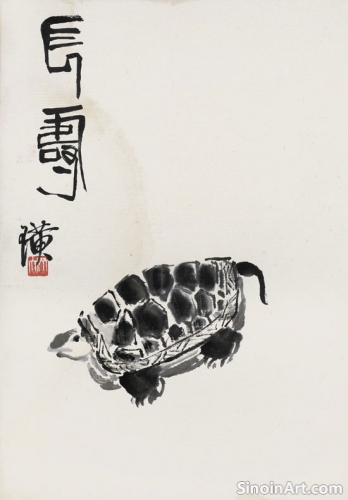The Influence of Taoism on Xieyi Painting
|
Taoism, with its emphasis on living in harmony with nature, has significantly influenced the development of Xieyi painting. The Taoist concept of the Tao (道), the underlying principle of the universe, is reflected in the ways that Xieyi artists capture the flow of life.  The Taoist principle of wu wei (無為), or "non-action," encourages artists to let their brushstrokes flow naturally, mirroring the natural movements of the world. The intention is to follow the flow of life, avoiding the pursuit of forced artistic effort, which is mirrored through the use of natural brushwork.  The Taoist emphasis on the interconnectedness of all things is reflected in the way Xieyi artists portray the relationship between different elements in their paintings. Nature is viewed as a unified whole, and individual elements are depicted in their relationship with the larger environment. This holistic approach to artwork mirrors Taoist ideals.  The appreciation for nature and its inherent beauty is also a key element in Taoism and Xieyi painting. Artists seek to capture the essence and spirit of natural forms, reflecting the Taoist belief that nature is a source of wisdom and inspiration. By embracing spontaneity, intuition, and a deep connection with nature, Xieyi artists create works that reflect the core principles of Taoism. The interplay between form and spirit is reflective of a deeply ingrained cultural and philosophical perspective. |
Tag : Taoism and Xieyi Painting, Xieyi and Daoism, Taoist Influence on Art, Naturalism in Chinese Painting, Ink Painting Philosophy
Related information
- The "Three Perfections" in Xieyi
- The Enduring Significance of Xieyi Painting
- The Spirit of Xieyi: An Introduction to Chinese Literati Painting
- Xieyi Painting and the Concept of "Yuan Qi"
- The Symbolism of Xieyi: Expressing Inner Worlds
The "Three Perfections" (sānjué) – poetry, calligraphy, and painting – represent the holistic literati ideal, emphasizing the integration of these three art forms as a complete expression of the artist's personal feeling, thought, and their connection to tradition, with calligraphy’s influence often seen in Xieyi’s brushwork.
Xieyi painting's enduring significance lies in its rich history, philosophical depth, and emphasis on personal expression, spontaneity, and the pursuit of essence, connecting with audiences through its timeless aesthetic, connection to nature, and human spirit, while contemporary artists ensure its continued practice, evolution, and relevance in the world of art.
Xieyi, often translated as sketching thoughts or freehand style, is a significant genre within Chinese painting. It is characterized by its emphasis on capturing the essence and spirit of a subject rather than its exact appearance. This expressive, spontaneous approach prioritizes the artist's personal emotions and inner vision.
"Yuan Qi" (original vital energy) is a core concept in Xieyi, representing the fundamental creative energy of the universe, pursued by artists aiming to capture the inner essence and inherent vitality of their subjects, requiring balance, mindfulness, and a deep connection with nature, imbuing their works with a sense of purpose and powerful intent.
This article explores the symbolic elements within Xieyi painting, focusing on how subjects, composition, and brushwork contribute to the expression of the artist's inner world and cultural values.